 I offered some cooked chicken bones today for the crabby tribe. Shinto seemed to be enjoying them two minutes after they were placed in the 'tat!
I offered some cooked chicken bones today for the crabby tribe. Shinto seemed to be enjoying them two minutes after they were placed in the 'tat!
7/30/2010
Photo Shoot
 I offered some cooked chicken bones today for the crabby tribe. Shinto seemed to be enjoying them two minutes after they were placed in the 'tat!
I offered some cooked chicken bones today for the crabby tribe. Shinto seemed to be enjoying them two minutes after they were placed in the 'tat!
7/29/2010
A Crabby Tale
Instead, Indi quickly began making a dash for a resin log and I thought he had put down the mouse... little did I know, he had the pinkie mouse trailing behind him! He was running off with the little mouse in hand.
Aria quickly followed him into the resin log. I don't know what happened in here, but Indi emerged on the other side victorious with the pinkie mouse in pincher. Aria came out the other side and decided to munch on some grapefruit instead.
7/28/2010
Freshly Harvested!
 Hand-harvesting items for your land hermit crabs is a great way to give them organic, natural foods for free! It's great to connect back to nature and take a long hike while getting some delicious delectables for your crabs.
Hand-harvesting items for your land hermit crabs is a great way to give them organic, natural foods for free! It's great to connect back to nature and take a long hike while getting some delicious delectables for your crabs.Oak leaves, maple leaves, basswood leaves, swordfern, cattail... there are so many possibilities! Today, I harvested some oak, maple, and moss for the crabs and for my store. It was a great day!
To learn more about items you can harvest, click here.
To purchase pre-harvested items from my store, click here.
7/23/2010
Food Trial: Pinkie Mice
 Pinkie mice, commonly sold frozen in the pet store for reptiles, are a great source of proteins and other nutrients. They're fast-thawing and easy to serve. It gives the crabs a real-life experience because crabs are scavengers and enjoy picking at dead animals.
Pinkie mice, commonly sold frozen in the pet store for reptiles, are a great source of proteins and other nutrients. They're fast-thawing and easy to serve. It gives the crabs a real-life experience because crabs are scavengers and enjoy picking at dead animals.I recently tried pinkie mice with my crabs and it was a huge success! I bought 3 for $5.00 and the crabs completely consumed (or hid) the first mouse I gave them.
If you're not squeamish and you can stomach feeding this type of food, I strongly suggest it! Your crabs will love this!
7/21/2010
Food Trials: Crabby Jello
 As previously posted, I am trialing crabby jello (a mixture of plain gelatin and hibiscus tea) in order to see if the crabs like it because I wanted to add it to my store.
As previously posted, I am trialing crabby jello (a mixture of plain gelatin and hibiscus tea) in order to see if the crabs like it because I wanted to add it to my store.Well, last night, I saw a few crabs picking at it! I think it would be more fun if I had put in different items into the jello (baby shrimp, krill, fruits, or vegetables, for example). I might try this next.
So far, it seems like a good crabby treat to put in with the other Kili's Bakery items. It does have one downside, however: it melts a little overnight. By the morning, your perfect scoop of jello turns more into jelly. Oh well!
Bon appetit!
7/20/2010
Food Bits: Avocado
 The avocado is known to be a favorite food for land hermit crabs. The avocado is native to the Caribbean, Central America, and South America, making it a common fruit that C. clypeatus and C. compressus could come across in the wild. Avocados are scientifically a fruit, bearing a large seed in the middle. Avocados are normally eaten plain, cooked with another food, or served as guacamole, a type of dip.
The avocado is known to be a favorite food for land hermit crabs. The avocado is native to the Caribbean, Central America, and South America, making it a common fruit that C. clypeatus and C. compressus could come across in the wild. Avocados are scientifically a fruit, bearing a large seed in the middle. Avocados are normally eaten plain, cooked with another food, or served as guacamole, a type of dip.Avocados are a great source of fiber, vitamin C and K, and folate. Here you can view all of the nutritional facts regarding the avocado.
 Avocados are a great way to treat your crabs to a healthy treat. Land hermit crabs require fresh fruits and vegetables in order to maintain their bodily systems and regulate bodily functions.
Avocados are a great way to treat your crabs to a healthy treat. Land hermit crabs require fresh fruits and vegetables in order to maintain their bodily systems and regulate bodily functions.The avocado possesses special cancer-fighting properties, cardiovascular benefits, and cholesterol-lowering power. It is a great antioxidant for land hermit crabs.
One interesting fact I found while researching more about this amazing fruit is that it helps the body absorb carotenoids. If this were also true with land hermit crabs, avocado would be a great food to serve along side other color-enhancing foods like red and orange bell peppers, carrots, cilantro, and spirulina.
It is important to know that when feeding avocado, you use only the ripe meat. The skin, seed, and leaves of the plant are considered toxic to mammals, and haven't been thoroughly tested on land hermit crabs.
Food Trials: Crabby Gelatin
 I've been looking for crab-safe desserts that are also healthy in order to add more to the "Kili's Bakery" section of my food store.
I've been looking for crab-safe desserts that are also healthy in order to add more to the "Kili's Bakery" section of my food store.I remember seeing a post from the HCA about making gelatin for the crabs and how gelatin is simply a protein and would be fine for the land hermit crabs.
So, today, I conjured up the idea of making a hibiscus jello, lightly sweetened with honey. It would retain the nutritional value of the hibiscus and honey and be a nice treat for the crabs. I could market it with a recipe, and it would be a great way of getting crabbers involved with preparing meals for their crabs.

So today, I got cooking. I prepared the gelatin like normal jello, only I boiled some hibiscus-chamomile tea on the stove and then added it to the gelatin mix. Then, I added some chilled hibiscus tea I had prepared earlier to finish the jello.

I didn't have any organic honey on hand, so I substituted a bit of organic maple syrup and turbinado cane sugar. These two items are both crab-safe if fed in small amounts, which is how I plan to feed the jello.
After finishing the gelatin mix, I placed it in the refrigerator to cool off, which is what it is currently doing. I am hoping it turns
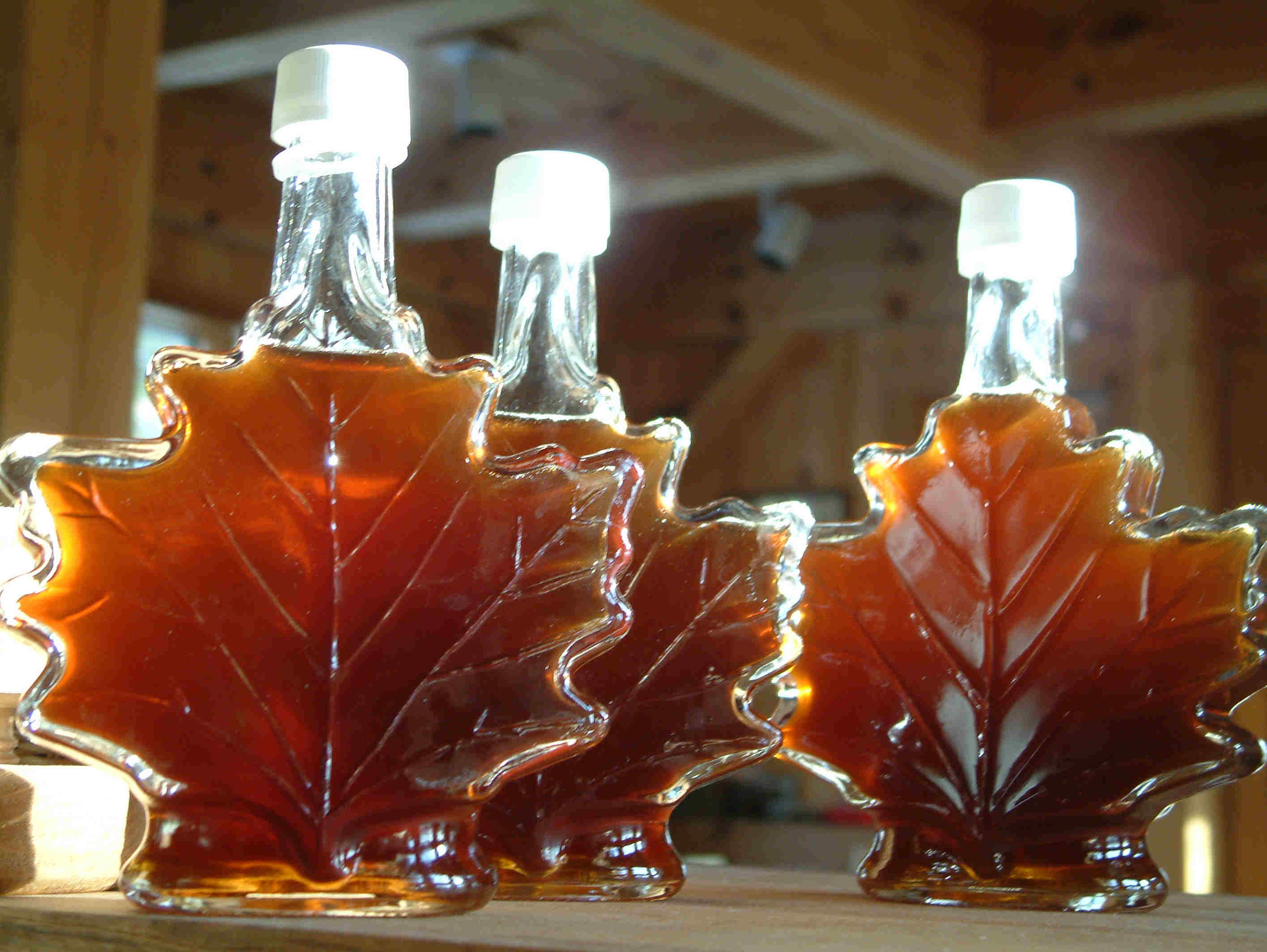 out tasty! I am eager to try some myself, being a hibiscus tea drinker.
out tasty! I am eager to try some myself, being a hibiscus tea drinker.After I've made the jello, trialed it myself, and taken a few pictures, I'll post some feedback here. I'm hoping it will be a hit with the crabs and there will be no issues with melting in the crabitat.
Bon appetit!
7/19/2010
7/17/2010
À la Carte (On the Menu)
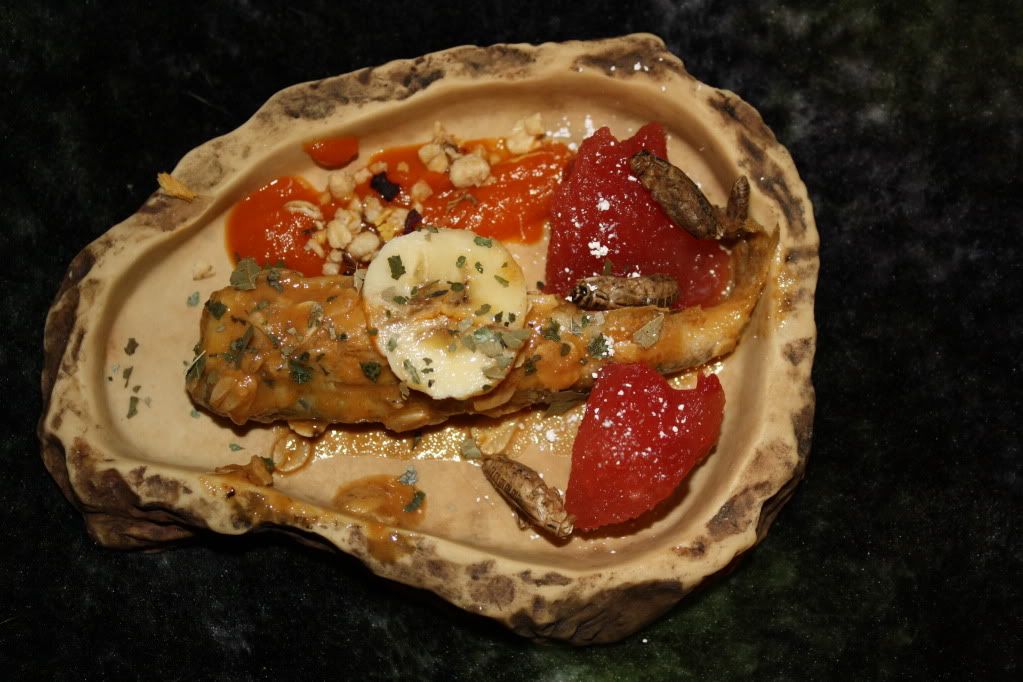
7/16/2010
Moss Pits
 Land hermit crabs love to explore, hide, and dig. These are three things that make them a great pet to watch from outside of the tank. They frequently do these activities during the night, but some crabs are so active, they'll even perform such activities during the day for all to see.
Land hermit crabs love to explore, hide, and dig. These are three things that make them a great pet to watch from outside of the tank. They frequently do these activities during the night, but some crabs are so active, they'll even perform such activities during the day for all to see. What is a great way of incorporating the natural love for exploring, hiding, and digging? A moss pit! In order to build your own moss pit for your crabs, you won't need much:
What is a great way of incorporating the natural love for exploring, hiding, and digging? A moss pit! In order to build your own moss pit for your crabs, you won't need much:-Moss (preferably a brand of reptile moss, such as Fluker's or Zilla - craft mosses do not work and can injure your crabs)
-A corner or back-wall shower caddy (found at Wal*Mart for $5.00 - $10.00)
-Saltwater
Once you have purchased these items, you're ready to prepare your own moss pit!
In order to create the moss pit, you'll want to rehydrate the dried moss that you bought. To do this, put it inside a microwave-safe bowl and fill the bowl with saltwater so the moss is drenched. Microwave for 5 minutes.
 After the moss has been microwaved, take it out and allow it to cool. Once cooled, drain the moss by squeezing out the excess saltwater. You can now place the moss inside of the caddy and stick it to one of the corners of the crabitat.
After the moss has been microwaved, take it out and allow it to cool. Once cooled, drain the moss by squeezing out the excess saltwater. You can now place the moss inside of the caddy and stick it to one of the corners of the crabitat.You can use many different mediums for the crabs to climb up to the shower caddy. Such mediums include cholla logs, fake plants, netting, or vines. Climbing into the moss provides good exercise and a comfy, humid spot for the crabs to rest. You can add more fun and stimuli by putting some of their favorite treats in the moss pits!
I hope your crabs will enjoy the moss pits. If they're anything like mine, your moss pits will soon become mosh pits!
One of my moss pits can be seen in this picture on the far right.
7/14/2010
An Anniversary and ELHC Crabs!
My order from ELHC (http://www.exoticlandhermitcrabs.com/) came in the mail today. The order came around 2:34 and I was very excited to open the package! All of the crabs came in different tupperware containers taped together.
Upon opening them, you could tell they were well treated before. Bob at ELHC does a great job caring for these crabs. None of them were shy so all were gender ID'd and named.
Without further adieu, I present the newest members of Kilimanjaro's Hermits:
7/13/2010
Finding the Right Tank Size
 Aquariums come in many different sizes. From the smallest 5 gallon aquariums to the largest 300 gallons and over aquariums, there are plenty of different sizes to choose. However, it may be hard to tell which aquarium size is good for you and your hermit crabs.
Aquariums come in many different sizes. From the smallest 5 gallon aquariums to the largest 300 gallons and over aquariums, there are plenty of different sizes to choose. However, it may be hard to tell which aquarium size is good for you and your hermit crabs.When looking for an aquarium, it is important to consider:
- Potential Upgrades
- How Many Crabs You Have (And May Acquire)
- Limitations
- Creativity
After considering these factors, finding a tank size should not be hard at all!
Potential Upgrades
It may seem unbelievable, but owning land hermit crabs is a fun hobby and can quickly become addicting. I started out with a ten gallon and quickly upgraded to a 20 gallon long, and now I own a 55 gallon which is becoming smaller every day.
Before you waste your money on purchasing a smaller tank, it is important to consider if you plan to expand your crab collection. Keep in mind that when properly kept, land hermit crabs can and will grow.
Basically, if you're planning on getting a smaller tank now, but would someday like a bigger tank, I would suggest going and buying the bigger right away.
How Many Crabs You Have (And May Acquire)
There is a chart available that is general rule for how many crabs you can keep in one tank, but the science (if little) is not really behind it. One should be able to tell how many crabs can fit comfortably in a tank. I would say no more than 3 small crabs in a 10G tank and definitely no larger sizes in a 10G. Of course, if you plan to use second levels (such as shower caddies) you may have more crabs.
As aforementioned, crabs are addictive and you will be wanting more. Again, go for larger now if you find this to be a serious hobby. Consider how many crabs you want and how many will fit comfortably in a certain size tank.
Limitations
It is understandable that you may live in an apartment and can't afford or fit a 55G in your room. Because of this, limitations must be considered. Crabs are a long-lasting pet (I wish I would have known this) and kids who may be going off to college must consider how they will care for them. This is the problem I am currently facing.
Look out for your limitations and pay attention to them. Don't swim in water that you're not comfortable with.
Creativity
This may not seem like an actual factor, but if you are a creative person, you'll fit a lot of stuff in the crabitat and make the most out of it. If you're really creative, a big crabitat is like an open canvas, ready to painted.
If you're not creative, a big crabitat can still fit large decorations and make everything seem more natural. Smaller crabitats also have great possibility for looking like small ecosystems.
Summary
In the end, it's up to you to decide which tank size is best! Consider the factors, and make a decision!
7/11/2010
Personalities of Land Hermit Crabs
 Although believed to be "throwaway pets", animals that live for a month, or "living" souvenirs from a vacation, land hermit crabs are truly exotic and fascinating creatures when placed in a proper habitat. Crabs have many different personalities, and a crabber can get to know their crabs by observing them throughout the day.
Although believed to be "throwaway pets", animals that live for a month, or "living" souvenirs from a vacation, land hermit crabs are truly exotic and fascinating creatures when placed in a proper habitat. Crabs have many different personalities, and a crabber can get to know their crabs by observing them throughout the day.  Some land hermit crabs are very shy and will only come out at night when no one is watching. Some land hermit crabs are active and are constantly out. Some land hermit crabs are bold and do not mind the presence of humans.
Some land hermit crabs are very shy and will only come out at night when no one is watching. Some land hermit crabs are active and are constantly out. Some land hermit crabs are bold and do not mind the presence of humans. I have had crabs of numerous personalities, all of which are a little different. I have had crabs who are willing to eat from my hand, and I have had crabs who will never come out of their shell when approached.
I have had crabs of numerous personalities, all of which are a little different. I have had crabs who are willing to eat from my hand, and I have had crabs who will never come out of their shell when approached. Alejandro is very active and loves climbing over everything. He also isn't extremely shy. Lucio is a much more shy crab and prefers to hide during the day. If my hand or face approaches the tank, Lucio is quick to dart in the opposite direction. Santino isn't extremely shy, but he is a little bit. He has a lot of personality for such a small crab: he managed to bring up an almond slice all the way to the top of one of my highest decorations!
Alejandro is very active and loves climbing over everything. He also isn't extremely shy. Lucio is a much more shy crab and prefers to hide during the day. If my hand or face approaches the tank, Lucio is quick to dart in the opposite direction. Santino isn't extremely shy, but he is a little bit. He has a lot of personality for such a small crab: he managed to bring up an almond slice all the way to the top of one of my highest decorations!7/09/2010
Food Bits: Almond
 As an intro, I would just like to introduce what "Food Bits" posts will be. I will try to introduce one crab-safe food every week and break it down: where it comes from, nutritional facts, and how to serve it to the crabs. You can trial the foods at home with your hermits and comment on how the crabs liked each food!
As an intro, I would just like to introduce what "Food Bits" posts will be. I will try to introduce one crab-safe food every week and break it down: where it comes from, nutritional facts, and how to serve it to the crabs. You can trial the foods at home with your hermits and comment on how the crabs liked each food! Almonds come from a tree native to the Middle East. There, they are found inside of the harder, inedible outer hull. The inside is the true nut, while the entire fruit is known as a drupe. Once the outer hull is removed, the inside may be eaten. Some popular methods are to eat them raw or roasted, and usually with salt.
Almonds come from a tree native to the Middle East. There, they are found inside of the harder, inedible outer hull. The inside is the true nut, while the entire fruit is known as a drupe. Once the outer hull is removed, the inside may be eaten. Some popular methods are to eat them raw or roasted, and usually with salt. Nutritionally, almonds are particularly high in protein, fats, and vitamin E. These foods are an excellent source of plant-based protein for your land hermit crabs, but be sure to substitute in meat-based proteins such as fish and poultry, too.
Nutritionally, almonds are particularly high in protein, fats, and vitamin E. These foods are an excellent source of plant-based protein for your land hermit crabs, but be sure to substitute in meat-based proteins such as fish and poultry, too.  The type of almonds that should be served to land hermit crabs are raw, unroasted/unsalted almonds. These can be found, usually, in any grocery store, but they are expensive. However, if you're planning on using them for the crabs only, they will last over one year. The crabs will also be able to eat roasted/unsalted almonds. Salted almonds are never a good choice for land hermit crabs.
The type of almonds that should be served to land hermit crabs are raw, unroasted/unsalted almonds. These can be found, usually, in any grocery store, but they are expensive. However, if you're planning on using them for the crabs only, they will last over one year. The crabs will also be able to eat roasted/unsalted almonds. Salted almonds are never a good choice for land hermit crabs. To serve the almonds, you can slice them in thin slivers using a sharp knife or grater. You can also use a food processor to powder or puree the almonds with a little spring water or organic fruit juice. I have given my crabs almonds in the following methods: slivers, grated into a powder, and puréed with organic apple juice. The crabs loved the slivers!
To serve the almonds, you can slice them in thin slivers using a sharp knife or grater. You can also use a food processor to powder or puree the almonds with a little spring water or organic fruit juice. I have given my crabs almonds in the following methods: slivers, grated into a powder, and puréed with organic apple juice. The crabs loved the slivers! Shells
 The shell of a land hermit crab is vital to survival. Land hermit crabs do not make their own shells, however. Nature designed them with a certain flaw: they have a soft abdomen. To support and protect this soft abdomen, the crab must find a way to protect it. The seashell is a perfect match.
The shell of a land hermit crab is vital to survival. Land hermit crabs do not make their own shells, however. Nature designed them with a certain flaw: they have a soft abdomen. To support and protect this soft abdomen, the crab must find a way to protect it. The seashell is a perfect match. Seashells are hard and offer protection from moisture loss, heat, and predators. Land hermit crabs and seashells co-evolved to form a perfect team. The shells, of course, are produced naturally by snails: either land or sea. Once the snail dies, the shell becomes vacant and a land hermit crab can move in. This is the perfect way to recycle the shell!
Seashells are hard and offer protection from moisture loss, heat, and predators. Land hermit crabs and seashells co-evolved to form a perfect team. The shells, of course, are produced naturally by snails: either land or sea. Once the snail dies, the shell becomes vacant and a land hermit crab can move in. This is the perfect way to recycle the shell! Different species of land hermit crabs like different types of shells. There are numerous species of shells. Some popular types are babylon, turbos, and nerites. Of course, these aren't the only type of shells for land hermit crabs. There are many different types!
Different species of land hermit crabs like different types of shells. There are numerous species of shells. Some popular types are babylon, turbos, and nerites. Of course, these aren't the only type of shells for land hermit crabs. There are many different types!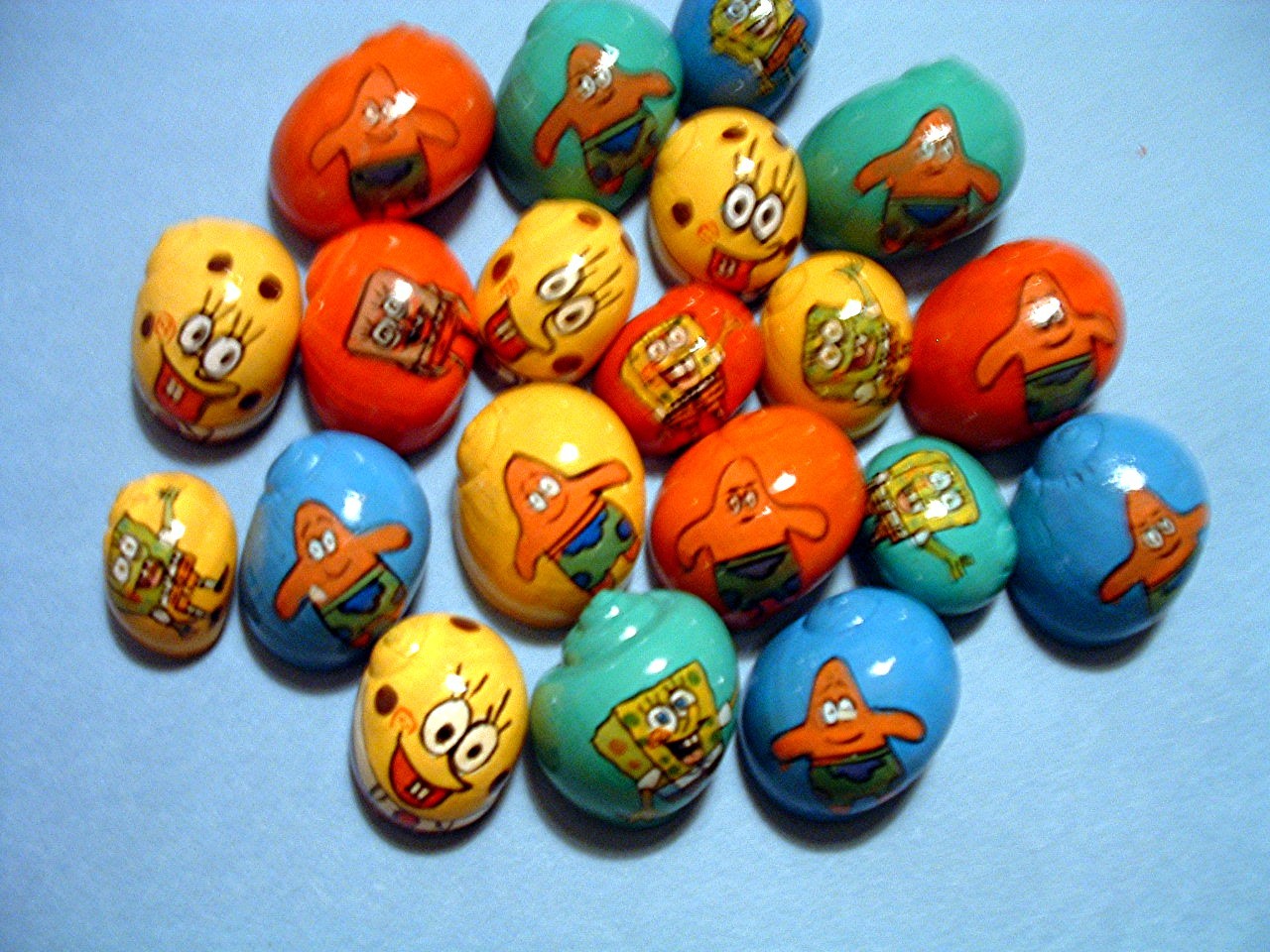 Natural shells are what is advocated here by me, but some people offer painted shells. I do not believe painted shells are a good choice because some paint may be toxic, and there are horrible stories of how manufacturers force land hermit crabs out of natural shells and into painted shells. Some crabs are even permanently glued to their shells!
Natural shells are what is advocated here by me, but some people offer painted shells. I do not believe painted shells are a good choice because some paint may be toxic, and there are horrible stories of how manufacturers force land hermit crabs out of natural shells and into painted shells. Some crabs are even permanently glued to their shells!From the seller's point of view, a crab in a Spongebob shell will sell better than a crab in a beat-up magpie shell. Since hermit crabs are marketed towards children, the Spongebob shell will sell more, but the crab's health is of no concern. This is why painted shells are condemned by most of the crabbing community. Besides, natural shells are simply beautiful. Why cover something up that is already perfect?
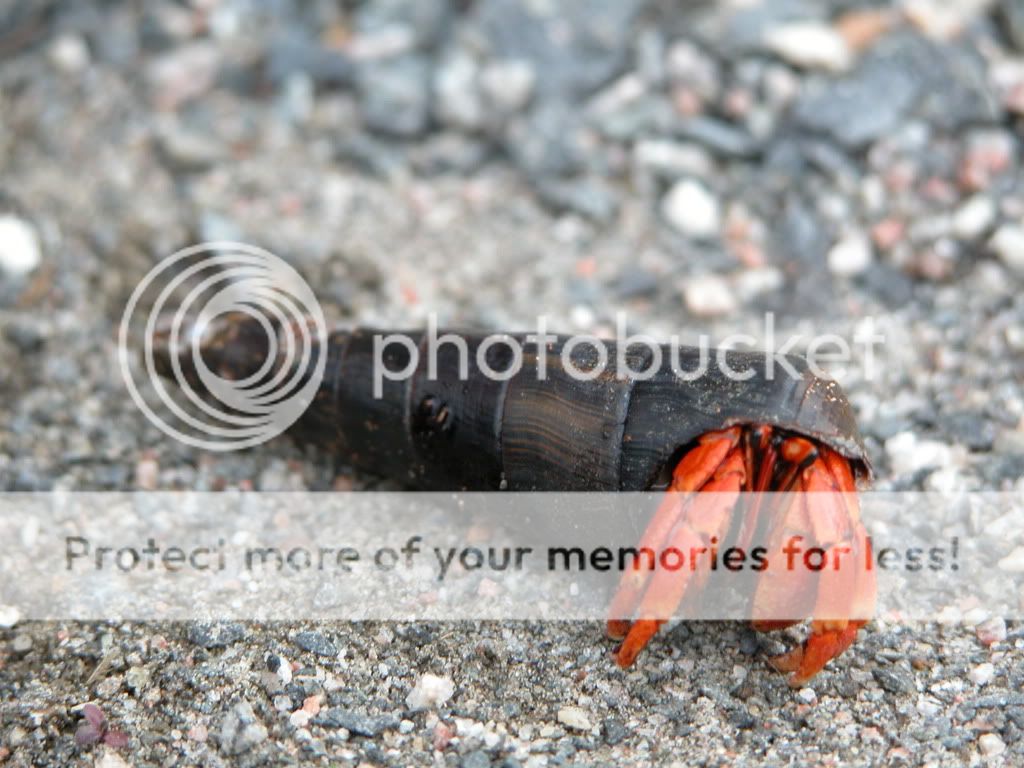 And to close this post, I would like to refer you to a friend of mine's blog regarding hermit crab shells: Hermit Crab Shell Selection. There you can find more information on the shells that each individual species prefers and a lot more!
And to close this post, I would like to refer you to a friend of mine's blog regarding hermit crab shells: Hermit Crab Shell Selection. There you can find more information on the shells that each individual species prefers and a lot more! 7/08/2010
Photo Shoot
 Above is my current crabitat, home to 15 (soon to be 23) land hermit crabs of all different species. It is a 55 gallon 'tat with a mixture of CaribSea and Eco-Earth as substrate. It features five shower caddies: three corner caddies which hold shells, one corner caddy that holds moss, and a back shower caddy with moss. Plenty of places to climb and hide inside! I am getting some fake vine and branches in the post soon, so the 'tat will look even more natural after that!
Above is my current crabitat, home to 15 (soon to be 23) land hermit crabs of all different species. It is a 55 gallon 'tat with a mixture of CaribSea and Eco-Earth as substrate. It features five shower caddies: three corner caddies which hold shells, one corner caddy that holds moss, and a back shower caddy with moss. Plenty of places to climb and hide inside! I am getting some fake vine and branches in the post soon, so the 'tat will look even more natural after that!7/07/2010
ELHC Shipping Delayed
 Today, I got the news that shipping on ELHC hermit crabs has been delayed due to the heat wave that is gripping us here in the Northeast. With temperatures in some places over 100*F, shipping the crabs could be dangerous and fatal.
Today, I got the news that shipping on ELHC hermit crabs has been delayed due to the heat wave that is gripping us here in the Northeast. With temperatures in some places over 100*F, shipping the crabs could be dangerous and fatal.7/05/2010
Cooking for Your Crabs
Of course, this leaves us, the crabbers, which a decision to make: should we feed any of this food? Most crabbers opt to leave out the staple foods found in pet stores from their crab's diet. Besides, preparing a natural diet can be quite simple and the hermits can eat most of the things you can, but of course, with a few exceptions.
Here are two meals that I've prepared for my crabs:
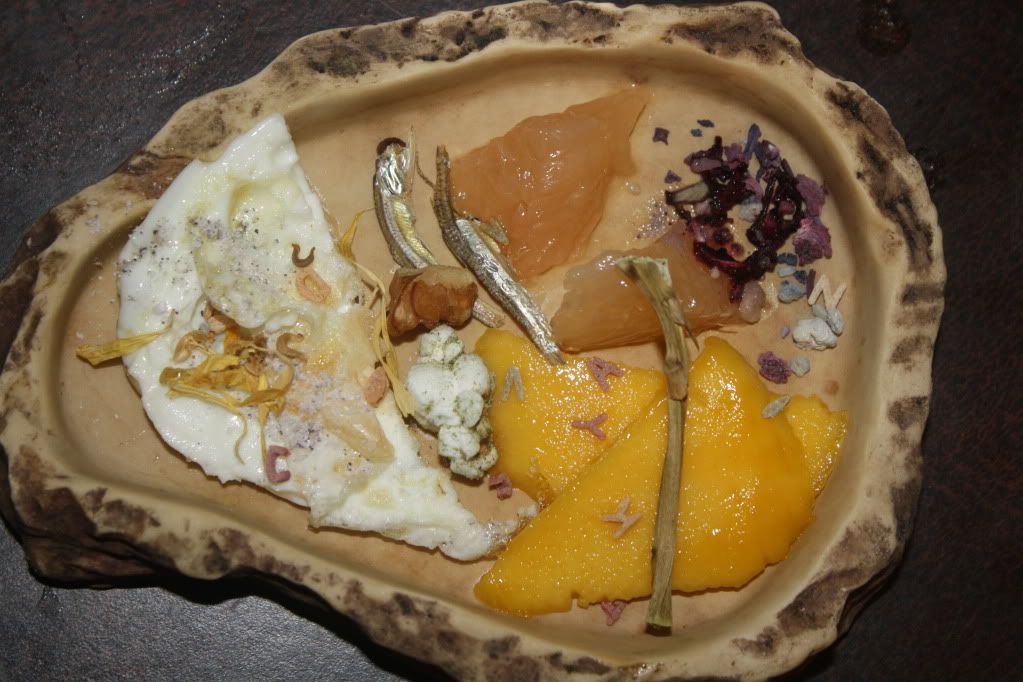
The above is EVOO fried egg, blue cornmeal, anchovies, hibiscus cuttlebone treat, dried asparagus, kelp-dusted popcorn, walnut, fresh grapefruit, fresh mango, organic alphabet pasta, and calendula petals.
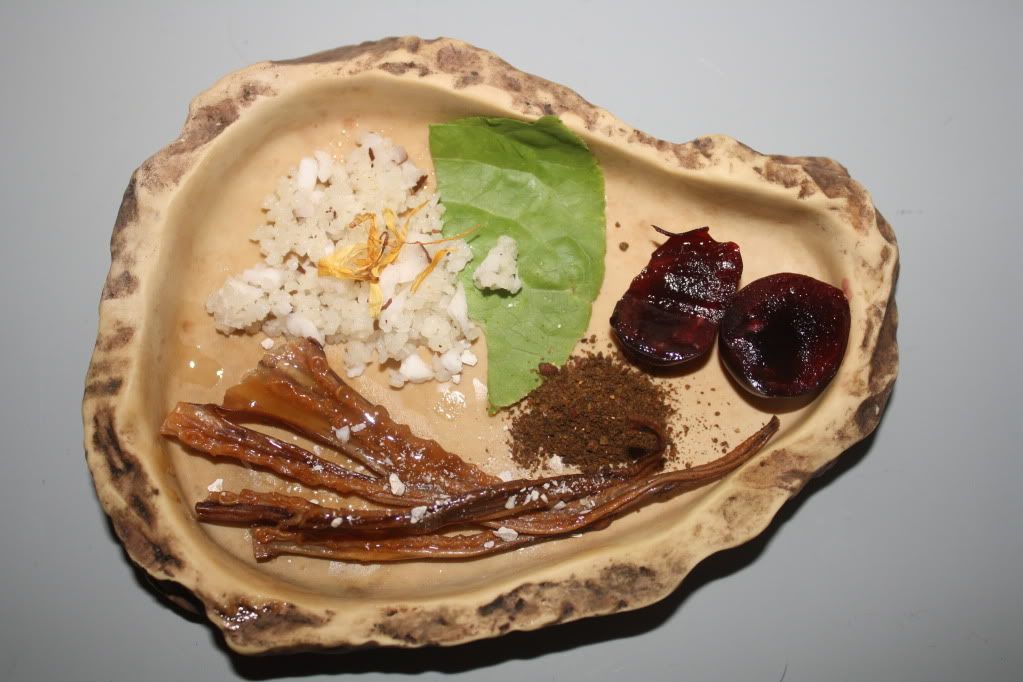
The above is saltwater rehydrated tentacles with honey glaze, coconut couscous with a calendula garnish, home-grown organic lettuce, fresh cherry, and my own Kilimanjaro's Kibble.
A natural diet consists of all types of foods that are healthy for hermit crabs. If you need more to understand the nutritional needs of the land hermit crab, look under "Kilimanjaro's Resources" for "Kilimanjaro's Guide to Land Hermit Crab Nutrition" on the left-side panel.
There, one can find all the information needed to feed your hermit crabs naturally, without worrying you're not giving them enough nutrition. With a little practice, a natural diet can be easy to accomplish.
And of course, it is necessary to mention that there are people out there who have the natural diet and busy crabber in mind. One can buy completely natural dry kibbles that you can easily feed to the crabs. Just keep in mind that fresh foods should be offered frequently, and dried foods are not an equal substitute for all the time!
You can click on the shopping links on the left-side panel to find some of these great kibbles. Keep on crabbin'!
3 New Ecuadorians



7/03/2010
Preparing for the ELHC Hermits
I am going to reorganize the 55G, which is currently housing my other 12 hermit crabs. I'm going to do a semi-deep clean and change out the pools and moss. I think I might buy a few extra plants and a hidey to make it a little more natural. I am also going to add some aragonite sand to my 100% EE mix, as recommended by many other crabbers.
I've had so many successful molts on pure EE, but also a lot of unsuccessful molts. If other crabbers are having better success with a mix, I am going to try it, too. I'm looking for what's best for the crabs.
Of course, while I'm out shopping for all of these extra things, I know of a store that has Ecuadorian crabs... I might have to bring home three. My current Ecuadorian, Kiléa, has been left alone due to a series of bad molts and PPS.
Luckily, with the addition of the eight crabs from ELHC and the three Es I'm planning to get, I'll be back to a nice colony... 23!
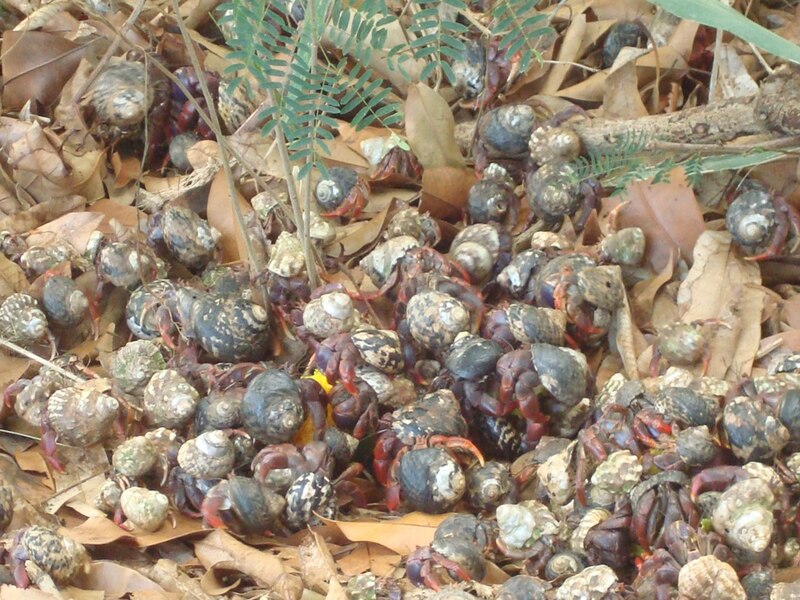
7/02/2010
Summer Update Post
1) Ryukyu, my biggest Viola, died. I am not sure why, but he spent a lot of time near the water pools and eventually went naked. He died a few days later. I still wonder why he died.
2) One of my Strawberries from HCV died. This came as a true surprise to me as the Strawberries from HCV have been doing great and are now celebrating their anniversaries with me!
I've had a few other losses and I've been researching why the mysterious deaths have been happening. I'm going to try a few different things: more fresh foods and less dried stuff, and also changing the water (even though it is filtered) more often.
Anyway, happy crabbing! The rest of the crew seems to be doing great and I'm looking forward to getting my ELHC exotics on WEDNESDAY!



























 Koopa Troopa, Coenobita purpureus
Koopa Troopa, Coenobita purpureus 





